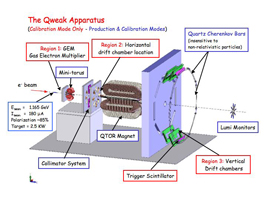2007 News Release
On the Cover of PRL: New Particles Get Mass Boost

The "Q-weak" apparatus: The upcoming Q-weak measurement at Jefferson Lab will lead to an extremely precise determination of the weak charges of the quarks.
A sophisticated, new analysis has revealed that the next frontier in some areas of particle physics is farther away than once thought. The masses of these new forms of matter, not predicted by the Standard Model of nuclear and particle physics, must be at least twice as large as previous constraints had allowed. Ross Young is the lead author on the just-published study, which was featured on the cover of Physical Review Letters.
To see the infinitely small bits of matter that make up our universe, physicists build ever more powerful accelerators, the microscopes they use to see matter. But while the trend is to more powerful accelerators, the precision achieved by some less powerful ones can pinpoint the best places to look for never-before-seen particles. It turns out that high-precision measurements can reveal the signature of new forms of matter.
In a recent study, Jefferson Lab scientists combined data from two Jefferson Lab experiment groups, G-Zero and HAPPEx, and from the PVA4 collaboration at Mainz and SAMPLE at MIT-Bates. These groups conducted experiments in which electrons were used to precisely probe the nucleus of the atom.
The experiments studied the weak nuclear force, one of the four forces of nature. Using the experimental data from all of these groups, Jefferson Lab researchers precisely determined the effects of the weak force on the building blocks of the proton, up and down quarks.
Moreover, when this new analysis was combined with still other measurements, it raised the predicted mass scale for the discovery of new particles to about one Tera-electron-volts (1 TeV) — more than a factor of two higher than previously thought. The discovery is noteworthy, because experimental improvements of this magnitude rarely occur more often than once in a decade.
The result also shows one possible impact of data from the upcoming Q-weak experiment in Jefferson Lab's Hall C. It shows that, with Q-weak's anticipated accuracy, the experiment will improve the current analysis's measurement of the effects of the weak force on up and down quarks by a factor of five. It could also raise the predicted mass for new particles another 1 TeV.
The Physical Review Letters paper was published on September 21 and was authored by four Jefferson Lab scientists/Users: Ross Young (JLab and University of Adelaide), Roger Carlini (JLab and College of William & Mary), Tony Thomas (JLab Chief Scientist and College of William & Mary), and Julie Roche (Ohio University).
Technical Paper
R. D. Young, R. D. Carlini, A. W. Thomas and J. Roche, Phys. Rev. Lett. 99 , 122003 (2007)
Jefferson Lab is managed and operated for the U.S. Department of Energy's Office of Science by Jefferson Science Associates, LLC, a joint venture between Southeastern Universities Research Association, Inc. and CSC Applied Technologies Division, LLC.

